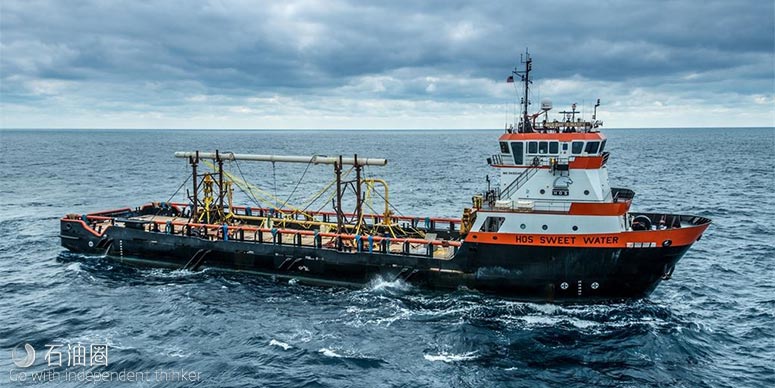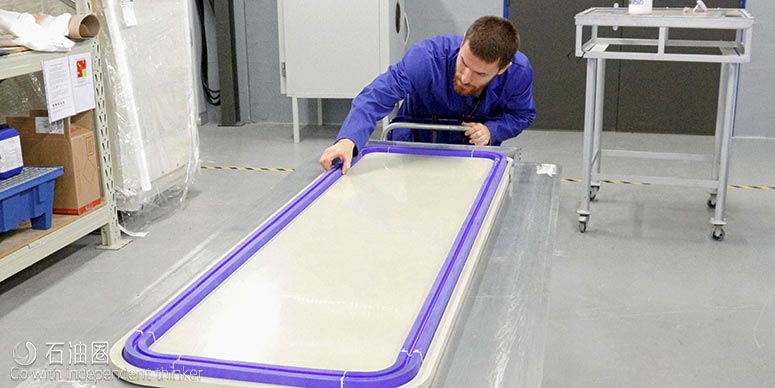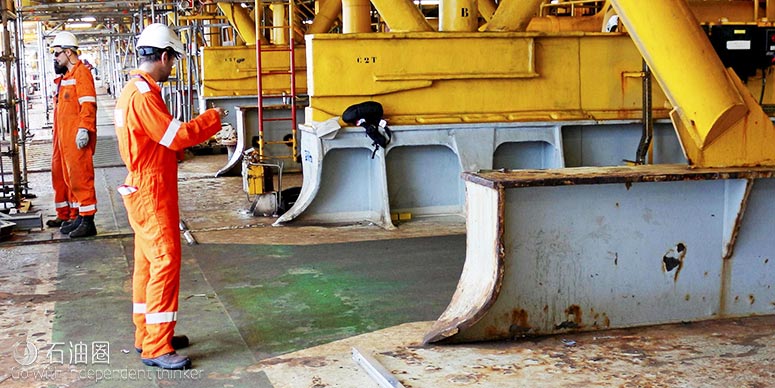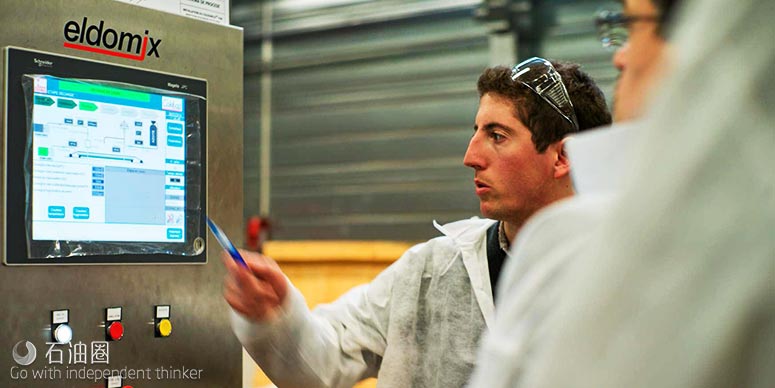This year sees the commercial debut of a repair technology that six-year-old French company ColdPad believes should have a major impact for reinforcement work aboard floating production vessels. Company founder and chief executive Jean-Philippe Court says: “Our bonded structural reinforcement Coldshield makes it possible to add new plate to corroded areas of an FPSO deck or such-like without the need for any welding work.”
Also, he continues: “We have the only system that is classapproved for reinforcement applications right up to the most demanding locations — such as for hull girder strength at midships areas.”
The elimination of welding from such repair settings is highly significant. The tag “no hot work” means that operations can go ahead while a floating production, storage and offloading vessel continues normal production.
No longer do repairs have to wait for production to be shut down, as needed with “hot work” techniques that involve welding new plate, with all its attendant risks in a hydrocarbon environment.
“Coldshield allows structural maintenance work to be shifted from planned shutdown periods to general maintenance operations,” says Christophe Paillusseau, vice president for sales and marketing at ColdPad.
Coldshield is the fruit of five years of work and €3 million ($3.5 million) worth of investment in a co-development programme with operator Total.
The result is a system that combines a top reinforcing plate, made of super duplex alloy, with a layer of structural polymers.
These internal polymers are surrounded by a compressed elastomeric peripheral seal that permanently protects them in an encapsulation that gives the assembly a lifetime that is put at 10 to 20 years.
Such pads can be formed to cover an area of anything up to five square metres, and they can be combined to cover larger areas.
ColdPad claims that 10 square metres of repair work can be carried out by a four-person team in just two days. This compares with 150 man-days likely to be needed using hot work methods if that repair is on top of a crude oil storage tank.
The topic of repair can be a sensitive one, of course. The very need for such work automatically indicates that levels of corrosion on an original structure have become extensive enough to call for remedial action, quite possibly somewhat earlier than expected.
This in turn might be seen as casting a small shadow over the adequacy of original anticorrosion measures.
Humid regions, such as off West Africa, are naturally among the most testing in this direction, and this is one of the areas where operators appear fairly open about their needs.
Set for Girassol
ColdPad is currently in the late stages of planning for a pioneering programme due to start late this year aboard Total’s giant Girassol FPSO off Angola.
Fifteen years after its installation, this 300-metre long floater — designed to produce 240,000 barrels per day of oil — is to be reinforced at a number of localised corrosion points on its structural deck that have arisen chiefly from failure or damage to its coating.
Between 50 and 60 Coldshield pads are due to be installed on Girassol’s deck plates in a work programme scheduled to take 40 days.
A total area of about 120 square metres will be covered, most of it on top of either crude oil storage tanks or seawater ballast tanks.
ColdPad’s founder is no stranger to the Girassol platform. During his many years as an offshore structural engineer Court was part of Total’s team on the subsea Rosa project, which ties into that FPSO.
That was when Court first formed the ideas that have resulted in ColdPad. He decided “to create what he would have loved to have then” — a cold work solution that could be used on an FPSO while normal production operations continued.
He formed ColdPad, based in Paris, in 2011. The company went on to conduct a threeyear research and development programme in conjunction with Total, IFP-Energies nouvelles, and several specialist laboratories.
After much trial and error, “we have turned on-site structural bonding into an industrial process”, says Paillusseau.
“Usually bonding strength has a lot of, shall we say, scattering, and this has a detrimental impact on its level of reliability. But we can predict the behaviour of our product and its performance over time,” he continues.
“Our real innovation comes from the process controlled manner in which we inject the structural polymer. In this way we can guarantee the injection is repeatable and its reliability and durability is enhanced.”
The central feature in achieving such repeatability is complete control of the atmospheric conditions that affect the polymeric resin. Right from the time of its first injection, on through its entire life, it is sealed away from the outside atmosphere to minimise ageing effects.
The first step in the installation sequence is to prepare the existing structure’s surface and then cover it with Coldshield’s “envelope” structure of top protection plate and elastomeric fluorosilicone perimeter seal. That seal is also a big part of the innovation that Coldpad has brought. “We got our inspiration from the aerospace industry,” says Paillusseau.
Next comes pressure reduction in the enclosed void. “We pull a vacuum for two reasons,” he explains.
“First we need to compress the seal. Then we move on to obtain fully controlled atmospheric parameters inside the void, dehydrating it and removing most oxygen. This is reproducible wherever we are and is patented as one of our key aspects.”
The final stage is vacuum injection of the structural polymeric resin that bonds to the substrate. To avoid unacceptable stress concentrations towards the edge of the pad, and to ensure strong and reliable bonding, “we introduce an ‘intermediate deformation layer’ made of low modulus polymer”, says Court.
“That involves a lot of knowhow and patents built up over years of research.”
Out on its own?
ColdPad claims the accolade of being “the only ‘cold’ reinforcement company to have class approval as a permanent repair methodology for hull structures, including hull girder strength aspects”.
This was gained from Bureau Veritas in April last year, and the certificate from American Bureau of Shipping followed a month later.
Whether ColdPad can claim this area of activity exclusively to itself is not entirely clear. Certainly, the only other specialist repair company with a significant presence in this field — UK outfit Intelligent Engineering (IE) — believes it also has “cold work” capabilities in much the same area that the French company is aiming at.
However, if IE’s capabilities do indeed match all those that ColdPad is claiming, that fact seems to be surprisingly little known among experts in the field.
The 21-year-old British company says it has used a “no hot work” variant of its sandwich plate system (SPS) on eight different FPSOs, as well as on several other types of platform as well.
The first of these was a threesquare metre repair of the bottom shell between existing stiffeners at the turn of bilge in an oil storage tank on FPSO Independence off Nigeria in 2003. Since then, project sizes have ranged up to 50 square metres.
The SPS arrangement uses a steel perimeter bar between the two plates. In a standard operation, this bar is welded to the steel plates. For the company’s “no hot work” variant, structural adhesive is used here instead of welding.
But IE has hardly shouted very loudly about this portion of its activities. So the differences in capabilities of the SPS system and of the new Coldshield rival have yet to become clear.
New entrant ColdPad is facing the future with enthusiasm, even if this year’s move onto the commercial scene comes somewhat later than it might have hoped.
The company endured a nailbiting period when the oil price collapsed three years ago just as its R&D programme was ending.
With co-developer Total slowing down its schedules off West Africa, ColdPad “spent its first year and a half in death valley, although now, if we look back, that was not so bad because it allowed us to think about other applications”.
Early christening
The Girassol operation will not quite be ColdPad’s first commercial project. In March this year, the company was lucky enough to be given the chance to trailblaze its Coldshield system in a contract from leading FPSO operator SBM Offshore at a unit off Equatorial Guinea.
After a five-month preparation period and a major finite element analysis, Coldshield was used to reinforce four steel brackets in a void space adjacent to an oil storage tank.
Five pads were used over a total area of about 10 square metres. The work was completed in less than a week.
Now the future is bright says Paillusseau. “Many of the 230 or so FPSOs around the world are ageing and it was always recognised they would need work after 10 to 15 years.”
The ColdPad technology generated considerable interest when presented by Total at this April’s MCE conference in Amsterdam.
Now the company is in discussions with a number of FPSO operators and believes new contracts could well be notched up in the coming months.

 石油圈
石油圈



